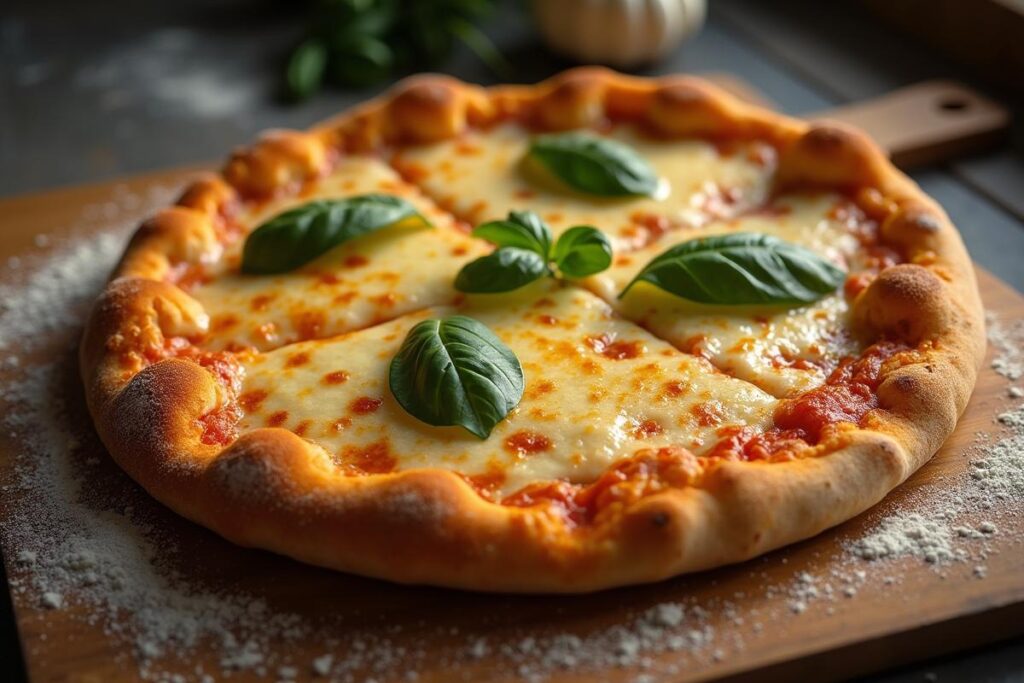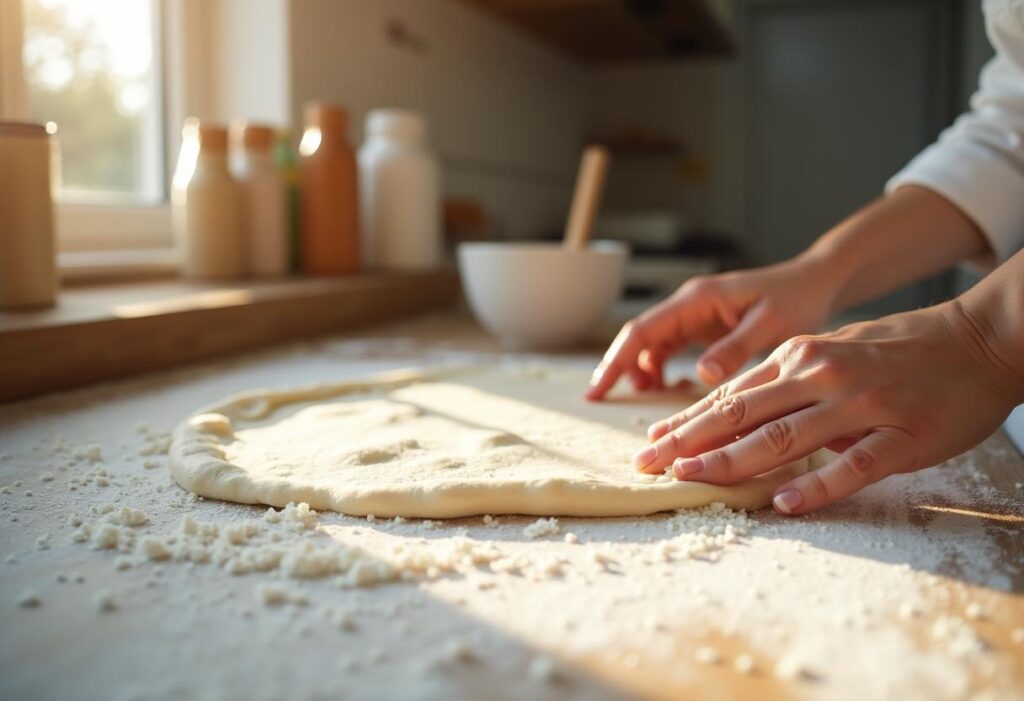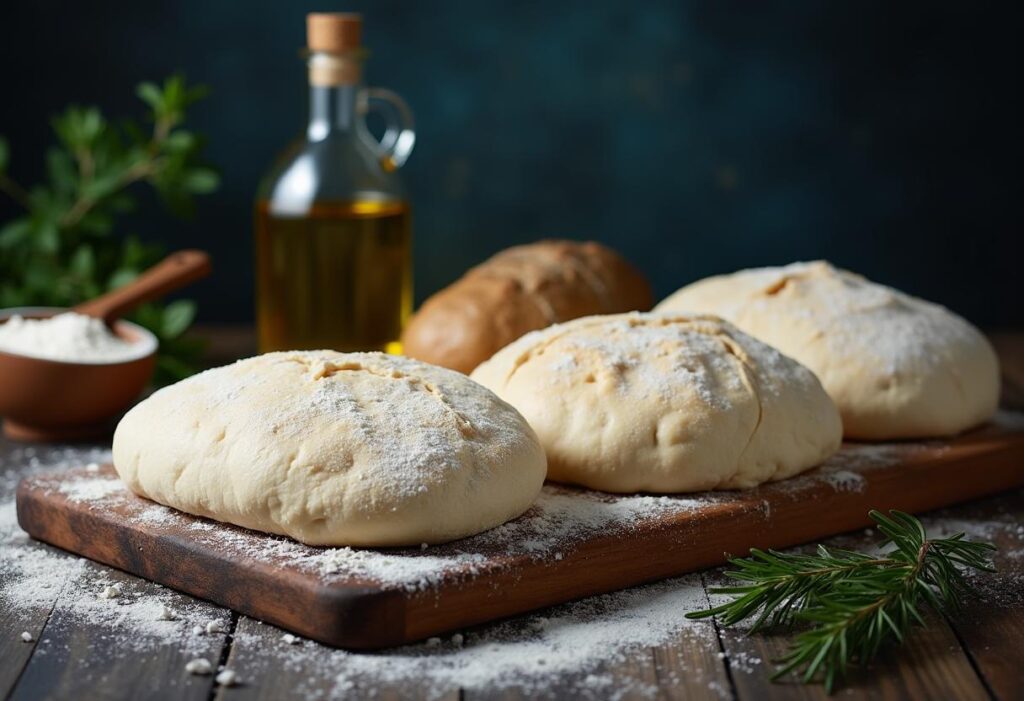
Table of Contents
Introduction to the Best Pizza Dough Recipe
There’s nothing quite like the taste of a freshly baked pizza with a perfectly crispy yet airy crust. After years of experimenting in the kitchen, I’ve come to realize that the foundation of any great pizza lies in the dough. Whether you prefer a Neapolitan-style crust or something a little thicker, the key to success starts with a tried-and-true pizza dough recipe.
Making pizza dough at home may sound intimidating, but trust me, it’s easier than you think. Plus, the results are absolutely worth it. When you craft your own dough, you have complete control over the flavor, texture, and thickness. Forget about store-bought options—homemade pizza dough is fresher, more flavorful, and more versatile.
In this article, I’ll walk you through my favorite recipe for pizza dough, the science behind it, and tips to avoid common mistakes. By the end, you’ll not only have the best pizza dough recipe in your arsenal but also the confidence to use it for all your pizza nights!
Ready to take your pizza game to the next level? Let’s dive in.
(Internal Link): Don’t miss our delicious homemade sauce guide to pair with your crust Check out Mark’s Pizza Sweet Sauce Recipe.
The Science Behind Perfect Pizza Dough
Making the perfect pizza dough isn’t just about following a recipe; it’s also understanding the science behind it. The way your ingredients interact and how you handle the dough will ultimately determine whether your crust is light, chewy, or crunchy. Here’s a closer look at what goes on behind the scenes.
The Role of Ingredients in Achieving Perfect Dough
Each ingredient in your pizza dough recipe plays a crucial role in achieving the ideal texture and flavor.
- Flour: The type of flour you use determines the strength of the dough. High-protein flours, like bread flour, create strong gluten networks that result in a chewy, elastic crust. All-purpose flour can work but won’t deliver the same structure.
- Water: Water hydrates the flour, activates the yeast, and helps form gluten. The right water-to-flour ratio is key. Too little water creates a dry dough, while too much leads to stickiness and weak structure.
- Yeast: Yeast is the powerhouse of pizza dough. It ferments the sugars in the flour, producing carbon dioxide that makes the dough rise. Active dry yeast, instant yeast, or even sourdough starters can be used depending on your preferences.
- Salt: Beyond flavor, salt helps control yeast activity and strengthens the gluten. Without it, your dough may rise too quickly and lack structure.
How Gluten Formation Impacts Texture
Gluten is the secret to the elasticity and strength of pizza dough. When you mix flour with water and knead the dough, gluten strands form, creating a stretchy network. This allows the dough to trap gas bubbles during fermentation, leading to an airy, light crust.
Kneading is where science meets skill. Proper kneading develops gluten without overworking it. If you knead too much, the dough can become tough. Not enough, and your crust might fall flat—literally.
Understanding this balance is what sets apart a good crust from a great one.
Essential Ingredients for the Best Pizza Dough Recipe
Creating the best pizza dough starts with selecting the right ingredients. Each one has a distinct role to play in ensuring your dough is flavorful, stretchy, and perfectly baked. Let’s break down the essential ingredients:
| Ingredient | Why It’s Important | Tips for Choosing |
|---|---|---|
| Flour | Forms the structure of the dough through gluten development. | Use high-protein bread flour for a chewy crust. For a softer texture, use all-purpose flour. |
| Water | Hydrates the flour, activates the yeast, and helps create gluten. | Use room-temperature filtered water to avoid chlorine disrupting the yeast. |
| Yeast | Leavens the dough, making it rise by creating air pockets. | Active dry yeast is reliable for beginners. For deeper flavor, try sourdough starters or fresh yeast. |
| Salt | Enhances flavor and controls yeast activity. | Use fine sea salt for even distribution. Don’t skip it—it stabilizes the gluten structure. |
| Olive Oil | Adds richness, flavor, and elasticity to the dough. | Use extra virgin olive oil for the best flavor and texture. |
| Sugar (Optional) | Feeds the yeast, aiding in faster fermentation and a golden crust. | Use granulated sugar or honey for a subtle sweetness. Skip if you prefer a less sweet crust. |
Why Quality Ingredients Matter
The quality of your ingredients directly affects the outcome of your pizza dough. For example, high-protein flour will give you a crust with better chewiness and structure, while low-quality yeast can lead to uneven rising. Using filtered water instead of tap water ensures no chemicals interfere with the fermentation process.
Step-by-Step Guide to Making the Best Pizza Dough

Making pizza dough may seem complicated, but with the right technique, you’ll create a masterpiece every time. Follow these steps to perfect your homemade dough:
1. Gather Your Ingredients
Before you begin, measure your ingredients carefully to ensure precision. For a standard recipe:
- 3 ½ cups of bread flour
- 1 ½ teaspoons of salt
- 1 packet of active dry yeast (or 2 ¼ teaspoons)
- 1 cup of lukewarm water (filtered)
- 2 tablespoons of extra virgin olive oil
- 1 teaspoon of sugar (optional)
2. Activating the Yeast
- In a small bowl, mix the yeast, sugar, and lukewarm water. Stir gently and let it sit for 5-10 minutes until it’s foamy.
- Pro Tip: If the mixture doesn’t foam, your yeast may be inactive. Start over with a new packet.
3. Mixing the Dough
- In a large bowl, combine the flour and salt. Create a small well in the center of the bowl.
- Pour in the activated yeast mixture and olive oil. Slowly mix with a wooden spoon or your hands until the dough comes together.
4. Kneading the Dough
- Transfer the dough onto a lightly floured surface. Knead for 8-10 minutes, pushing and folding the dough until it’s smooth and elastic.
- Test for readiness by pressing a finger into the dough. If it springs back, it’s ready.
5. First Rise: Letting the Dough Rest
- Place the dough in a lightly oiled bowl, cover it with a damp cloth, and let it rise in a warm place for 1-2 hours, or until it doubles in size.
- Pro Tip: For extra flavor, refrigerate the dough overnight for a slow fermentation process.
6. Shaping the Dough
- Punch down the dough to release excess air, then divide it into equal portions (if making multiple pizzas).
- Roll or stretch each portion into your desired shape. For a traditional pizza, aim for a 12-inch circle.
7. Final Proofing
- Allow the shaped dough to rest for 15-30 minutes before adding toppings. This ensures a light, airy crust during baking.
Next Steps
Your dough is now ready for toppings and baking! In the next section, we’ll discuss common pizza dough mistakes and how to avoid them.
Common Pizza Dough Mistakes to Avoid
Even the best pizza dough recipe can fail if a few critical mistakes are made along the way. Avoid these common errors to ensure your crust turns out perfect every time.
1. Over-Kneading or Under-Kneading the Dough
Kneading develops the gluten structure, which is essential for elasticity and a chewy texture.
- Over-kneading: The dough becomes overly tight, making it hard to stretch and resulting in a dense crust.
- Under-kneading: Without enough gluten development, the dough can’t hold air, leading to a flat and tough crust.
Solution: Knead the dough just until it’s smooth and elastic, around 8-10 minutes. Use the “windowpane test” to check readiness—stretch a small piece of dough. If it forms a thin, translucent layer, it’s ready!
2. Using the Wrong Flour
The type of flour you choose can make or break your dough. Low-protein flours, like cake flour, won’t create the gluten strength needed for pizza.
Solution: Stick with bread flour for a chewy crust or all-purpose flour for a softer texture. Experimenting with 00 flour can yield an authentic Neapolitan-style crust.
3. Misjudging the Proofing Time
Under-proofed dough doesn’t rise properly, while over-proofed dough loses structure and collapses.
Solution: Allow the dough to rise until it has doubled in size. This typically takes 1-2 hours, depending on room temperature. For better flavor, try slow fermentation in the fridge for 24-48 hours.
4. Skipping the Preheat or Using a Low Oven Temperature
A lukewarm oven can ruin your pizza crust by not providing enough heat for proper browning and crispiness.
Solution: Always preheat your oven to the highest temperature possible (around 500°F/260°C). A pizza stone or steel can improve heat distribution for a better crust.
Next Steps
Now that you know what to avoid, let’s explore exciting pizza dough variations in the next section!
Pizza Dough Variations You’ll Love

If you’ve mastered the basics of pizza dough, why not experiment with variations to suit different tastes and dietary needs? From sourdough to gluten-free options, here are some unique pizza dough styles to try.
1. Sourdough Pizza Dough: A Flavorful Twist
Sourdough pizza dough is made using a natural sourdough starter instead of commercial yeast.
- Why it’s special: The fermentation process produces a tangy, complex flavor and a chewy crust. It’s also more digestible for many people due to the breakdown of gluten during fermentation.
- How to make it: Replace the yeast in your recipe with ½ cup of active sourdough starter. Allow for a longer fermentation time, as natural leavening takes more time.
Pro Tip: For best results, use a sourdough starter that’s been recently fed and is bubbling with activity.
2. Gluten-Free Pizza Dough: For Everyone to Enjoy
Gluten-free pizza dough is perfect for those with gluten sensitivities or celiac disease.
- Key ingredients: A mix of gluten-free flours like rice flour, almond flour, or a pre-made gluten-free flour blend. Xanthan gum or psyllium husk is often added to mimic the elasticity of gluten.
- Texture: Expect a slightly softer, denser crust compared to traditional dough, but with the right recipe, it can still be crispy on the edges.
Pro Tip: Pre-bake the gluten-free crust for 5-7 minutes before adding toppings to prevent it from becoming soggy.
3. Whole Wheat Pizza Dough: A Healthier Option
Whole wheat dough provides a nutty flavor and added nutrients compared to refined flour options.
- Flavor and texture: It’s denser and more flavorful but requires slightly more water to hydrate the whole grains properly.
- How to make it: Substitute up to 50% of the flour in your recipe with whole wheat flour.
Pro Tip: For a lighter crust, mix whole wheat flour with bread flour in a 50/50 ratio.
Next Steps
Whether you’re looking for a tangy sourdough crust or a gluten-free option, these variations add versatility to your pizza game. In the next section, learn how to store and reuse your dough effectively.
Storing and Reusing Pizza Dough
Homemade pizza dough can be made in advance and stored for later use, saving you time on your next pizza night. Here’s how to store, freeze, and reuse your dough while maintaining its quality and flavor.
1. Storing Pizza Dough in the Refrigerator
- Short-term storage: After the dough has risen, place it in an airtight container or wrap it tightly in plastic wrap. Store it in the refrigerator for up to 3 days.
- Why it works: Refrigeration slows down the fermentation process, which enhances the flavor of the dough.
- Pro Tip: Bring the dough to room temperature for about 30 minutes before rolling it out. Cold dough is harder to stretch.
2. Freezing Pizza Dough for Long-Term Storage
Freezing is the best way to store pizza dough for more than a few days.
- How to freeze: After the first rise, divide the dough into portions. Coat each portion lightly with olive oil, place it in a freezer-safe bag, and remove excess air before sealing.
- How long it lasts: Frozen dough can be stored for up to 3 months without losing quality.
3. Rehydrating and Reviving Dough
- Thawing frozen dough: Transfer the dough to the refrigerator 12-24 hours before you plan to use it. Once thawed, let it rest at room temperature for 30-60 minutes.
- Rehydrating stale dough: If refrigerated dough feels dry, knead it with a small amount of water or olive oil to restore its elasticity.
4. Avoiding Common Storage Mistakes
- Don’t skip the olive oil coating—it prevents the dough from drying out in the freezer.
- Avoid leaving dough in the refrigerator for too long, as it may over-ferment and develop a sour taste.
Next Steps
Now that you’ve mastered storing your dough, let’s dive into common questions about pizza dough in the next section.
FAQs About Pizza Dough
When it comes to making pizza dough, there’s no shortage of questions! Here are answers to some of the most commonly asked questions to help you perfect your dough-making skills.
What is the trick to good pizza dough?
The secret to great pizza dough lies in three key factors:
Proper hydration: A higher water-to-flour ratio creates a softer, more pliable dough. Aim for about 60-65% hydration for a well-balanced crust.
Patience: Allowing the dough to rise slowly (preferably overnight in the refrigerator) enhances its flavor.
Kneading technique: Knead the dough enough to develop gluten without overworking it.
Pro Tip: Always use high-quality ingredients like bread flour and extra virgin olive oil for the best results.
What is the 55 rule for pizza?
The “55 rule” refers to a simple guideline for pizza dough preparation:
55% hydration: Use water that is 55% of the weight of the flour.
55-second stretch and fold: Stretch and fold the dough for 55 seconds during the kneading process to evenly develop gluten.
This rule ensures consistency and structure in your dough.
How does Gordon Ramsay make pizza dough?
Chef Gordon Ramsay’s pizza dough recipe includes:
Bread flour for structure.
Instant yeast for a quick rise.
A touch of olive oil for added elasticity and flavor.
Ramsay emphasizes using a hot oven and a pizza stone for the perfect crispy crust.
What is the best type of dough for pizza?
The “best” type depends on your preferences:
Neapolitan: Thin, airy crust made with 00 flour.
New York-style: Chewy, foldable crust using bread flour.
Gluten-free: Made with alternative flours like almond or rice flour for dietary needs.
Is pizza dough better the longer you let it rise?
Yes! Longer rising times, especially when done in the refrigerator, allow for slow fermentation. This improves flavor, texture, and elasticity. However, dough should not rise for more than 72 hours, as it may over-ferment and collapse.
What is the most important ingredient in pizza dough?
Flour is the most crucial ingredient because it forms the base of the dough and determines its texture. High-protein bread flour is ideal for developing a strong gluten structure, which creates a chewy and airy crust.
Next Steps
Now that your pizza dough questions are answered, let’s explore how to pair it with the perfect toppings in the next section!
Pairing the Dough with the Perfect Pizza Toppings

The toppings you choose can either elevate your homemade pizza dough or overpower it. Pairing the right toppings with the texture and flavor of your dough is essential for achieving a perfect bite every time.
1. Matching Dough Texture with Toppings
- Thin Crust (Neapolitan-style): Light and airy crusts work best with minimalist toppings. Stick to simple combinations like fresh mozzarella, basil, and San Marzano tomato sauce. Too many toppings can weigh the dough down and make it soggy.
- Chewy Crust (New York-style): A versatile dough that can handle heavier toppings like pepperoni, sausage, and extra cheese without collapsing.
- Crispy Crust (Gluten-free or Whole Wheat): These sturdier bases are great for bold toppings like BBQ chicken, caramelized onions, or roasted vegetables.
2. Choosing the Right Sauce
The sauce is a foundational element that ties the flavors together:
- Classic Tomato Sauce: Perfect for most styles of dough and toppings. Use fresh or canned San Marzano tomatoes for a rich, tangy base.
- White Sauce: A creamy alternative that pairs beautifully with thin crusts and delicate toppings like spinach and mushrooms.
- Pesto Sauce: Herbaceous and nutty, ideal for crispy crusts topped with grilled chicken or roasted vegetables.
3. Balancing Toppings and Flavors
- Cheese: Fresh mozzarella is a classic, but don’t overlook options like ricotta, goat cheese, or even a sharp cheddar for added depth.
- Proteins: Use cooked proteins like grilled chicken, bacon, or even shrimp to complement the dough’s texture.
- Vegetables: Roasted red peppers, spinach, or caramelized onions add bursts of flavor without overwhelming the crust.
Conclusion and Final Thoughts
Mastering the art of making the best pizza dough is a game-changer for any pizza lover. From understanding the science behind the ingredients to experimenting with dough variations and pairing it with the right toppings, the process is as rewarding as the delicious results.
The beauty of homemade pizza dough lies in its versatility. Whether you prefer a chewy New York-style crust, a light Neapolitan base, or even a gluten-free option, there’s a recipe and technique to suit your taste. By using quality ingredients, following key steps like proper kneading and proofing, and avoiding common mistakes, you’ll create a dough that’s far superior to anything store-bought.
Additionally, knowing how to store and reuse your dough gives you the freedom to enjoy fresh pizza anytime, with minimal effort. Pair your dough with flavorful sauces like classic tomato or pesto, and balance the toppings to enhance—not overpower—the crust.
So, what’s stopping you from rolling up your sleeves and making your own pizza dough today? The satisfaction of biting into a pizza you made entirely from scratch is unmatched. Plus, it’s a great way to get creative in the kitchen and impress your family or friends.
Ready to get started? Take what you’ve learned, gather your ingredients, and let the dough-making adventure begin. Your perfect pizza awaits!
